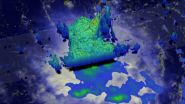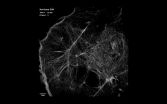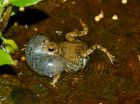(Press-News.org) The Global Precipitation Measurement or GPM core satellite has provided meteorologists with a look at the towering thunderstorms and heavy rainfall occurring in Tropical Storm Erika as it moves through the Caribbean Sea.
On August 27, 2015, there were many warnings and watches in effect as Tropical Storm Erika continued to rain on Leeward Islands. A Tropical Storm Warning was in effect for Anguilla, Saba and St. Eustatius, St. Maarten, St. Martin, St. Barthelemy, Montserrat, Antigua and Barbuda, St. Kitts and Nevis, Puerto Rico, Vieques, Culebra, U.S. Virgin Islands, British Virgin Islands. A Tropical Storm Watch was in effect for Guadeloupe, the northern coast of the Dominican Republic from Cabo Engano to the border of Haiti, the southeastern Bahamas and the Turks and Caicos Islands.
Tropical Storm Erika, the fifth named storm of the season, entered the northeast Caribbean early on the morning of August 27 as it passed through the Leeward Islands between Guadeloupe and Antigua. Fortunately, there were no reports of damage thanks in part to the effects of inhibiting wind shear, which kept the storm from strengthening.
Erika originated as a wave of low pressure that was first detected on Friday, August 21 midway between the West Coast of Africa and the Cape Verde Islands. The wave then tracked westward across the tropical mid Atlantic where it eventually intensified enough to become a tropical storm, Tropical Storm Erika, about three days later on the evening of August 24 (local time, EDT).
At this point, Erika was located about 955 miles due east of the Leeward Islands. However, despite being over warm water, Erika struggled to intensify as it approached the Leeward Islands over the next few days thanks to an upper-level tough of low pressure near Hispaniola in the north central Caribbean, which created westerly wind shear that disrupted the storm's circulation.
Two instruments aboard GPM captured an image of Erika at 17:26 UTC (1:26 p.m. EDT) on August 26 as the storm was nearing the Leeward Islands. Rain rates derived from the GPM Microwave Imager or GMI captured rain rates in outer area and the Dual-frequency Precipitation Radar or DPR instrument captured rain rates in the inner area. GPM showed rainfall of up to 52.8 mm (2.0 inches) per hour.
The images revealed that the low-level center of circulation was displaced well to the northwest of the storm's rain field, which contains areas of embedded convection (thunderstorms) necessary strengthen and maintain the storm. However, for the storm to intensify, those areas of convection need to be located close to the storm's core, which is not the case here due to the effects of wind shear. At about the time of this image, the National Hurricane Center reported that Erika's maximum sustained winds were near 45 mph, making it a weak tropical storm, and that Erika was experiencing moderate northwesterly wind shear as it moved westward near 17 mph.
At NASA's Goddard Space Flight Center in Greenbelt, Maryland, the DPR data was used to create a 3-D rendering of Erika. That 3-D image showed thunderstorm cloud tops reaching to just over 14 km (8.6 miles).
At 11 a.m. EDT (1500 UTC), the center of Tropical Storm Erika was located near latitude 16.4 North, longitude 63.3 West. Erika is moving toward the west near 16 mph (26 kph).
The National Hurricane Center (NHC) expects a turn toward the west-northwest later on August 27, and this general motion should continue for the next 48 hours. On the forecast track, the center of Erika will move near the Virgin Islands later today, move near or north of Puerto Rico tonight, and pass north of the north coast of the Dominican Republic on Friday.
Maximum sustained winds are near 50 mph (85 kph), and NHC expects little change in strength over the next two days. The estimated minimum central pressure is 1006 millibars.
For updates on the forecast and track, and local effects, visit the NHC web page: http://www.nhc.noaa.gov.
GPM is a joint mission between NASA and the Japanese space agency JAXA.
INFORMATION:
A University of Oklahoma astrophysicist and his Chinese collaborator have found two supermassive black holes in Markarian 231, the nearest quasar to Earth, using observations from NASA's Hubble Space Telescope. The discovery of two supermassive black holes--one larger one and a second, smaller one--are evidence of a binary black hole and suggests that supermassive black holes assemble their masses through violent mergers.
Xinyu Dai, professor in the Homer L. Dodge Department of Physics and Astronomy, OU College of Arts and Sciences, collaborated on this project ...
Alexandria, Va., USA - Today, the International and American Associations for Dental Research (IADR/AADR) published a Discovery! article titled "10 Years of a National Oral Health Policy in Brazil: Innovation, Boldness and Numerous Challenges." In it, authors Gilberto Alfredo Pucca, Jr., University of Brasília; and Mariana Gabriel, Maria Ercilia de Araujo and Fernanda Campos Sousa de Almeida, University of São Paulo, discuss Brazil's National Policy of Oral Health, also known as "Smiling Brazil."
Brazil is the only country with more than 200 million inhabitants ...
KINGSTON - Queen's University developmental psychology professor Stanka Fitneva has co-authored a study in the journal Science that, for the first time, explores the replicability of psychology research.
The Reproducibility Project: Psychology, launched nearly four years ago, is one of the first crowdsourced research studies in the field. The researchers' most important finding was that, regardless of the analytic method or criteria used, fewer than half of their studies produced the same findings as the original study.
"This is a unique project in psychology, and ...
Scientists can now watch dynamic biological processes with unprecedented clarity in living cells using new imaging techniques developed by researchers at the Howard Hughes Medical Institute's Janelia Research Campus. The new methods dramatically improve on the spatial resolution provided by structured illumination microscopy, one of the best imaging methods for seeing inside living cells.
The vibrant videos produced with the new technology show the movement and interactions of proteins as cells remodel their structural supports or reorganize their membranes to take up ...
A study that sought to replicate 100 findings published in three prominent psychology journals has found that, across multiple criteria, independent researchers could replicate less than half of the original findings. In some cases this may call into question the validity of some scientific findings, but it may also point to the difficulty of conducting effective replications and achieving reproducible results.
The results of this review study, conducted by more than 270 researchers on five continents, are published in the Aug. 28 issue of the journal Science. Twenty-two ...
This news release is available in Japanese.
Following one of the largest-scale scientific reproducibility investigations to date, a group of psychology researchers has reported results from an effort to replicate 100 recently published psychology studies; though they were able to successfully repeat the original experiments in most all cases, they were able to reproduce the original results in less than half, they report. The authors - part of the Reproducibility Project: Psychology, and led by Brian Nosek - emphasize that a failure to reproduce does not necessarily ...
This news release is available in Japanese.
Researchers have significantly extended the resolution of live-cell Structured Illumination Microscopy (SIM), a type of microscopy that offers many benefits compared to other super resolution techniques. The results are already providing a much more detailed understanding of cell processes and could have important implications for health research. Currently, many other super resolution microscopes come with pitfalls; for example, localization microscopy and stimulated emission depletion microscopy must use high ...
This news release is available in Japanese.
In the attempt to choose a mate, it's no surprise that females will select the more "attractive" of two males, but now a new study reveals that female túngara frogs are susceptible to the "decoy" effect, where the introduction of a third, inferior mate results in the female choosing the less attractive of the first two options. The results of this study counter the rational choice models that are currently used in sexual selection theory, suggesting they may prove inadequate to explain decisions in socially ...
HOUSTON - (Aug. 27, 2015) - Rice University scientists have made a living circuit from multiple types of bacteria that prompts the bacteria to cooperate to change protein expression.
The subject of a new paper in Science, the project represents the first time the Rice researchers have created a biological equivalent to a computer circuit that involves multiple organisms to influence a population.
The researchers' goal is to modify biological systems by controlling how bacteria influence each other. This could lead to bacteria that, for instance, beneficially alter ...
Before Ibuprofen can relieve your headache, it has to dissolve in your bloodstream. The problem is Ibuprofen, in its native form, isn't particularly soluble. Its rigid, crystalline structures -- the molecules are lined up like soldiers at roll call -- make it hard to dissolve in the bloodstream. To overcome this, manufacturers use chemical additives to increase the solubility of Ibuprofen and many other drugs, but those additives also increase cost and complexity.
The key to making drugs by themselves more soluble is not to give the molecular soldiers time to fall in ...





